Metakaolinite Phosphate Cementitious Matrix: Inorganic Polymer Obtained by Acidic Activation
Abstract
1. Introduction
2. Materials and Methods
3. Results
3.1. Stoichiometry of the Metakaolinite Phosphate Cementitious Binder
3.2. Microstructure
3.3. Mechanical Properties
4. Discussion
5. Conclusions
Supplementary Materials
Author Contributions
Funding
Conflicts of Interest
References
- Coppola, L.; Bellezze, T.; Belli, A.; Bignozzi, M.C.; Bolzoni, F.; Brenna, A.; Cabrini, M.; Candamano, S.; Cappai, M.; Caputo, D.; et al. Binders alternative to Portland cement and waste management for sustainable construction—Part 2. J. Appl. Biomater. Funct. Mater. 2018, 16, 207–221. [Google Scholar]
- Coppola, L.; Bellezze, T.; Belli, A.; Bignozzi, M.C.; Bolzoni, F.; Brenna, A.; Cabrini, M.; Candamano, S.; Cappai, M.; Caputo, D.; et al. Binders alternative to Portland cement and waste management for sustainable construction—Part 1. J. Appl. Biomater. Funct. Mater. 2018, 16, 207–221. [Google Scholar]
- Coppola, L.; Coffetti, D.; Crotti, E. An holistic approach to a sustainable future in concrete construction. IOP Conf. Ser. Mater. Sci. Eng. 2018, 442, 012024. [Google Scholar]
- Gopinath, S.; Murthy, A.R.; Iyer, N.I. A Novel Pre-Fabrication Technology to Produce Textile Reinforced Concrete Structural and Non-Structural Components. J. Sci. Ind. Res. 2016, 75, 735–739. [Google Scholar]
- Awani, O.; El-Maaddawy, T.; Ismail, N. Fabric-reinforced cementitious matrix: A promising strengthening technique for concrete structures. Constr. Build. Mater. 2017, 132, 94–111. [Google Scholar] [CrossRef]
- Duxson, P.; Provis, J.L.; Lukey, G.C.; van Deventer, J.S.J. The role of inorganic polymer technology in the development of “green concrete”. Cem. Concr. Res. 2007, 37, 1590–1597. [Google Scholar] [CrossRef]
- Provis, J.L.; Van Deventer, J.S.J. (Eds.) Alkali Activated Materials; Springer: New York, NY, USA, 2014; Volume 13, ISBN 978-94-007-7671-5. [Google Scholar]
- Wagh, A.S. Chemically Bonded Phosphate Ceramics—Twenty-First Century Materials with Diverse Applications; Elsevier: New York, NY, USA, 2004; ISBN 0-08-044548-9. [Google Scholar]
- Duxson, P.; Fernández-Jiménez, A.; Provis, J.L.; Lukey, G.C.; Palomo, A.; Van Deventer, J.S.J. Geopolymer technology: The current state of the art. J. Mater. Sci. 2007, 42, 2917–2933. [Google Scholar] [CrossRef]
- Wu, X.; Gu, J. Inorganic Resin Compositions, Their Preparation and Use Thereof. U.S. Patent US6103007A, 15 August 2000. [Google Scholar]
- Wastiels, J.; Van Ackeren, J.; Tysmans, T.; Van Paepegem, W. Flexural impact response of textile reinforced inorganic phosphate cement composites (TRC). Constr. Build. Mater. 2018, 163, 296–304. [Google Scholar] [CrossRef]
- Sabir, B.; Wild, S.; Bai, J. Metakaolin and calcined clays as pozzolans for concrete: A review. Cem. Concr. Compos. 2001, 23, 441–454. [Google Scholar] [CrossRef]
- Yanguatin, H.; Tobón, J.; Ramírez, J. Pozzolanic reactivity of kaolin clays, a review. Rev. Ing. Constr. 2017, 32, 13–24. [Google Scholar] [CrossRef]
- Hollanders, S.; Adriaens, R.; Skibsted, J.; Cizer, Ö.; Elsen, J. Pozzolanic reactivity of pure calcined clays. Appl. Clay Sci. 2016, 132–133, 552–560. [Google Scholar] [CrossRef]
- Liew, Y.M.; Kamarudin, H.; Mustafa Al Bakri, A.M.; Luqman, M.; Khairul Nizar, I.; Ruzaidi, C.M.; Heah, C.Y. Processing and characterization of calcined kaolin cement powder. Constr. Build. Mater. 2012, 30, 794–802. [Google Scholar] [CrossRef]
- Mejía de Gutiérrez, R.; Torres, J.; Vizcayno, C.; Castello, R. Influence of the calcination temperature of kaolin on the mechanical properties of mortars and concretes containing metakaolin. Clay Miner. 2008, 43, 177–183. [Google Scholar] [CrossRef]
- Ilić, B.R.; Mitrović, A.A.; Miličić, L.R. Thermal treatment of kaolin clay to obtain metakaolin. Hem. Ind. 2010, 64, 351–356. [Google Scholar]
- Castelein, O.; Soulestin, B.; Bonnet, J.P.; Blanchart, P. The influence of heating rate on the thermal behaviour and mullite formation from a kaolin raw material. Ceram. Int. 2001, 27, 517–522. [Google Scholar] [CrossRef]
- Cui, X.M.; Liu, L.P.; He, Y.; Chen, J.Y.; Zhou, J. A novel aluminosilicate geopolymer material with low dielectric loss. Mater. Chem. Phys. 2011, 130, 1–4. [Google Scholar] [CrossRef]
- Lemougna, P.N.; Wang, K.; Qing, T.; Melo, U.C. Recent developments on inorganic polymers synthesis and applications Patrick. Ceram. Int. 2016, 42, 15142–15159. [Google Scholar] [CrossRef]
- Duxson, P.; Provis, J.L.; Lukey, G.C.; Mallicoat, S.W.; Kriven, W.M.; Van Deventer, J.S.J. Understanding the relationship between geopolymer composition, microstructure and mechanical properties. Colloids Surf. A Physicochem. Eng. Asp. 2005, 269, 47–58. [Google Scholar] [CrossRef]
- Coppola, L.; Coffetti, D.; Crotti, E. Pre-packed alkali activated cement-free mortars for repair of existing masonry buildings and concrete structures. Constr. Build. Mater. 2018, 173, 111–117. [Google Scholar] [CrossRef]
- Perera, D.S.; Hanna, J.V.; Davis, J.; Blackford, M.G.; Latella, B.A.; Sasaki, Y.; Vance, E.R. Relative strengths of phosphoric acid-reacted and alkali-reacted metakaolin materials. J. Mater. Sci. 2008, 43, 6562–6566. [Google Scholar] [CrossRef]
- Tchakouté, H.K.; Rüscher, C.H. Mechanical and microstructural properties of metakaolin-based geopolymer cements from sodium waterglass and phosphoric acid solution as hardeners: A comparative study. Appl. Clay Sci. 2017, 140, 81–87. [Google Scholar] [CrossRef]
- Khabbouchi, M.; Hosni, K.; Mezni, M.; Zanelli, C.; Doggy, M.; Dondi, M.; Srasra, E. Interaction of metakaolin-phosphoric acid and their structural evolution at high temperature. Appl. Clay Sci. 2017, 146, 510–576. [Google Scholar] [CrossRef]
- Le-ping, L.; Xue-min, C.; Shu-heng, Q.; Jun-li, Y.; Lin, Z. Preparation of phosphoric acid-based porous geopolymers. Appl. Clay Sci. 2010, 50, 600–603. [Google Scholar] [CrossRef]
- Celerier, H.; Jouin, J.; Mathivet, V.; Tessier-Doyen, N.; Rossignol, S. Composition and properties of phosphoric acid-based geopolymers. J. Non. Cryst. Solids 2018, 493, 94–98. [Google Scholar] [CrossRef]
- Celerier, H.; Jouin, J.; Tessier-Doyen, N.; Rossignol, S. Influence of various metakaolin raw materials on the water and fire resistance of geopolymers prepared in phosphoric acid. J. Non-Cryst. Solids 2018, 500, 493–501. [Google Scholar] [CrossRef]
- Louati, S.; Hajjaji, W.; Baklouti, S.; Samet, B. Structure and properties of new eco-material obtained by phosphoric acid attack of natural Tunisian clay. Appl. Clay Sci. 2014, 101, 60–67. [Google Scholar] [CrossRef]
- Louati, S.; Baklouti, S.; Samet, B. Acid based geopolymerization kinetics: Effect of clay particle size. Appl. Clay Sci. 2016, 132–133, 571–578. [Google Scholar] [CrossRef]
- Louati, S.; Baklouti, S.; Samet, B. Geopolymers Based on Phosphoric Acid and Illito-Kaolinitic Clay. Adv. Mater. Sci. Eng. 2016, 2016. [Google Scholar] [CrossRef]
- Douiri, H.; Louati, S.; Baklouti, S.; Arous, M.; Fakhfakh, Z. Structural, thermal and dielectric properties of phosphoric acid-based geopolymers with different amounts of H3PO4. Mater. Lett. 2014, 116, 9–12. [Google Scholar] [CrossRef]
- Douiri, H.; Louati, S.; Baklouti, S.; Arous, M.; Fakhfakh, Z. Enhanced dielectric performance of metakaolin-H3PO4 geopolymers. Mater. Lett. 2016, 164, 299–302. [Google Scholar] [CrossRef]
- Douiri, H.; Kaddoussi, I.; Baklouti, S.; Arous, M.; Fakhfakh, Z. Water molecular dynamics of metakaolin and phosphoric acid-based geopolymers investigated by impedance spectroscopy and DSC/TGA. J. Non. Cryst. Solids 2016, 445–446, 95–101. [Google Scholar] [CrossRef]
- Katsiki, A. Aluminosilicate Phosphate Cements—A critical review [Davidge award 2018]. Adv. Appl. Ceram. Struct. Funct. Bioceram. 2019. [Google Scholar] [CrossRef]
- Farmer, V.C. The Infrared Spectra of Minerals; Mineralogical Society: London, UK, 1974; ISBN 9780903056533. [Google Scholar]
- Douiri, H.; Louati, S.; Baklouti, S.; Arous, M.; Fakhfakh, Z. Structural and dielectric comparative studies of geopolymers prepared with metakaolin and Tunisian natural clay. Appl. Clay Sci. 2017, 139, 40–44. [Google Scholar] [CrossRef]
- Davidovits, J. Geopolymer Chemistry & Applications, 4th ed.; Davidovits, J., Ed.; Geopolymer Institute: Saint-Quentin, France, 2015; ISBN 9782951482098. [Google Scholar]
- Guo, C.M.; Wang, K.T.; Liu, M.Y.; Li, X.H.; Cui, X.M. Preparation and characterization of acid-based geopolymer using metakaolin and disused polishing liquid. Ceram. Int. 2016, 42, 9287–9291. [Google Scholar] [CrossRef]
- Rahier, H.; Mele, B.; Wastiels, J. Low-temperature synthesized aluminosilicate glasses. J. Mater. Sci. 1996, 31, 80–85. [Google Scholar] [CrossRef]
- Liu, L.P.; Cui, X.M.; He, Y.; Liu, S.D.; Gong, S.Y. The phase evolution of phosphoric acid-based geopolymers at elevated temperatures. Mater. Lett. 2012, 66, 10–12. [Google Scholar] [CrossRef]
- Tchakouté, H.K.; Rüscher, C.H.; Kamseu, E.; Andreola, F.; Leonelli, C. Influence of the molar concentration of phosphoric acid solution on the properties of metakaolin-phosphate-based geopolymer cements. Appl. Clay Sci. 2017, 147, 184–194. [Google Scholar] [CrossRef]
- Tchakouté, H.K.; Rüscher, C.H.; Djobo, J.N.Y.; Kenne, B.B.D.; Njopwouo, D. Influence of gibbsite and quartz in kaolin on the properties of metakaolin-based geopolymer cements. Appl. Clay Sci. 2017, 107, 188–194. [Google Scholar] [CrossRef]
- Bednárek, J.; Ptáček, P.; Švec, J.; Šoukal, F.; Pařízek, L. Inhibition of Hydrogen Evolution in Aluminium-phosphate Refractory Binders. Procedia Eng. 2016, 151, 87–93. [Google Scholar] [CrossRef]
- Lassinantti Gualtieri, M.; Romagnoli, M.; Gualtieri, A.F. Preparation of phosphoric acid-based geopolymer foams using limestone as pore forming agent—Thermal properties by in situ XRPD and Rietveld refinements. J. Eur. Ceram. Soc. 2015, 35, 3167–3178. [Google Scholar] [CrossRef]
- Rüscher, C.H.; Mielcarek, E.; Lutz, W.; Ritzmann, A.; Kriven, W.M. Weakening of alkali-activated metakaolin during aging investigated by the molybdate method and infrared absorption spectroscopy. J. Am. Ceram. Soc. 2010, 93, 2585–2590. [Google Scholar] [CrossRef]
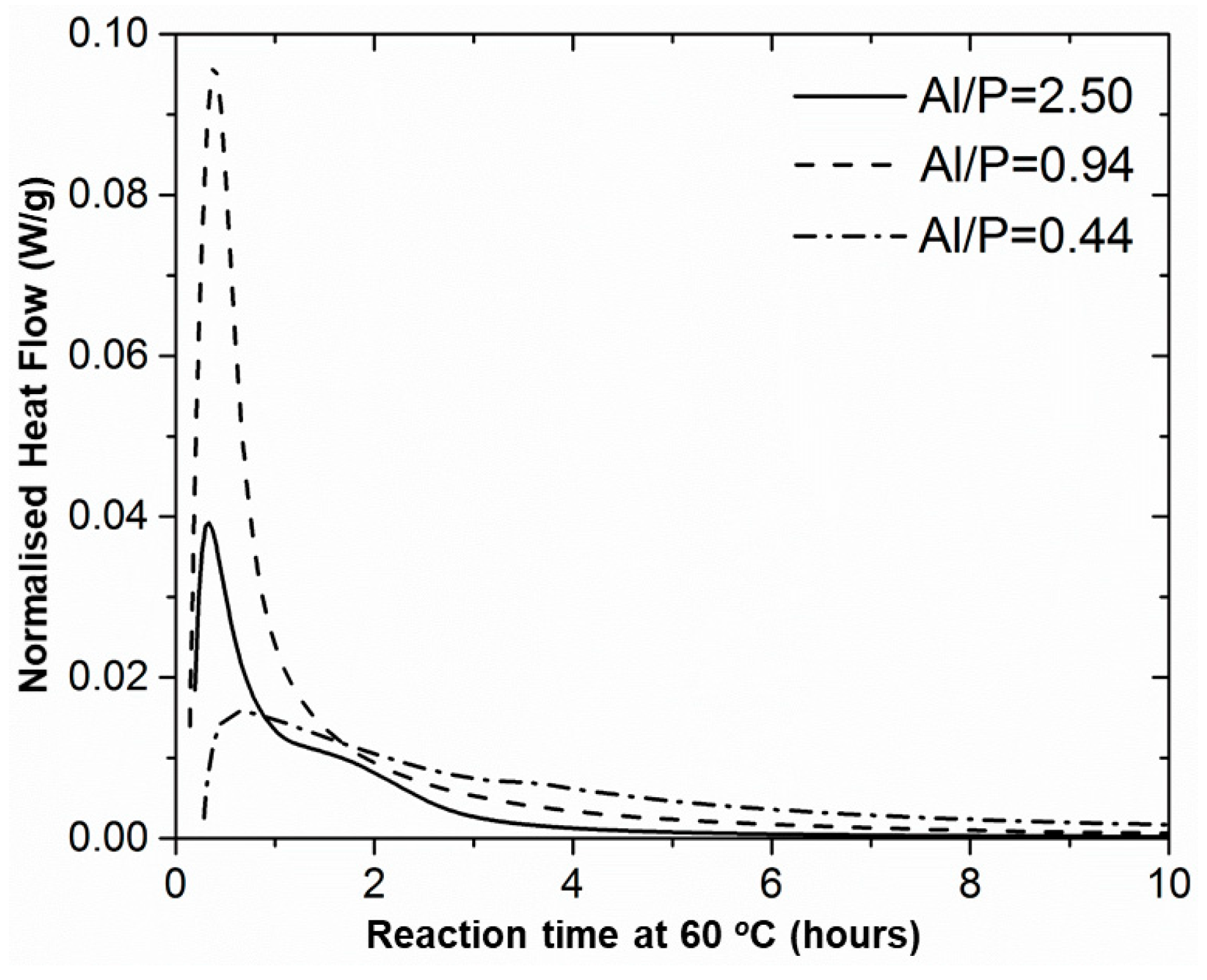

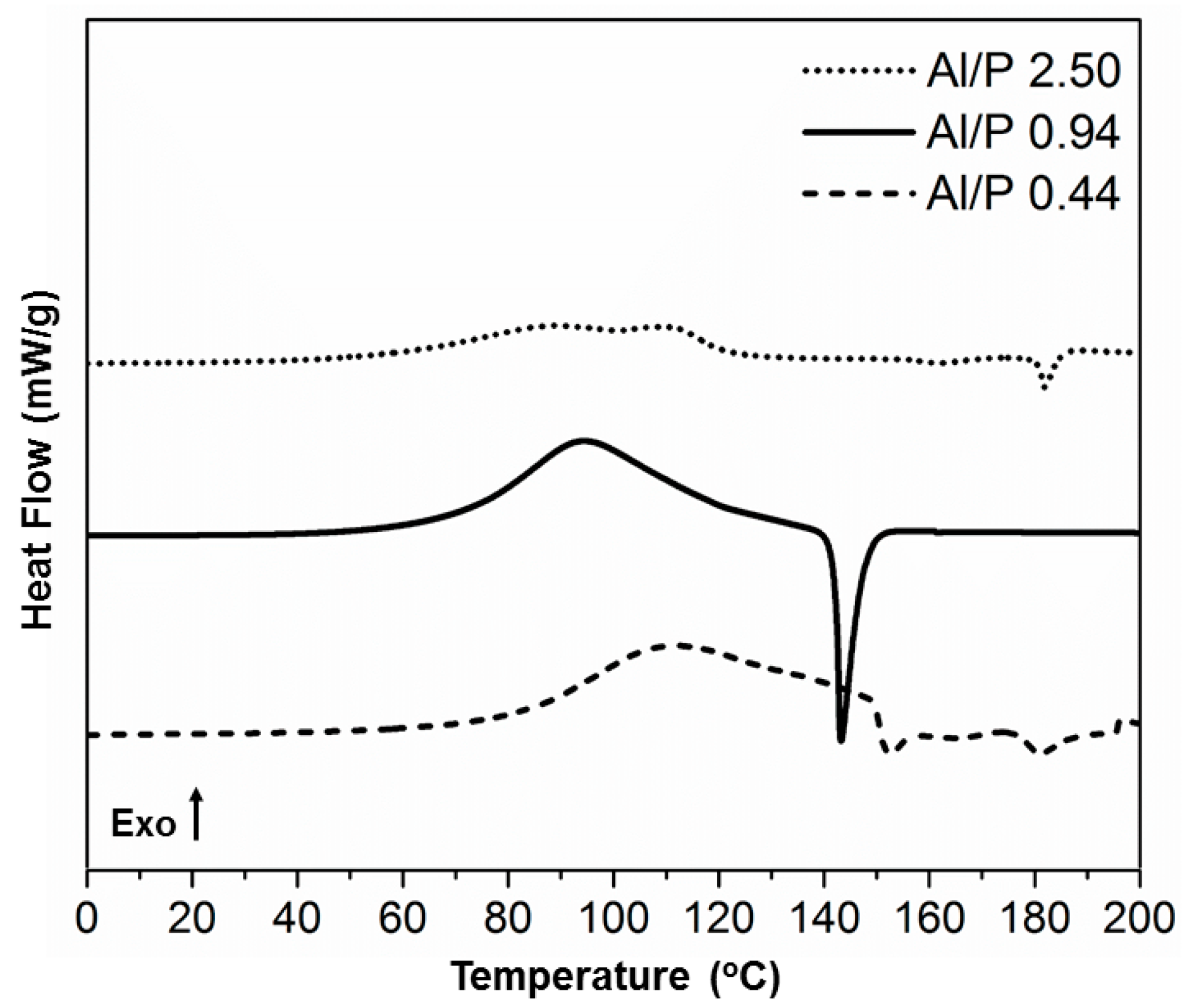
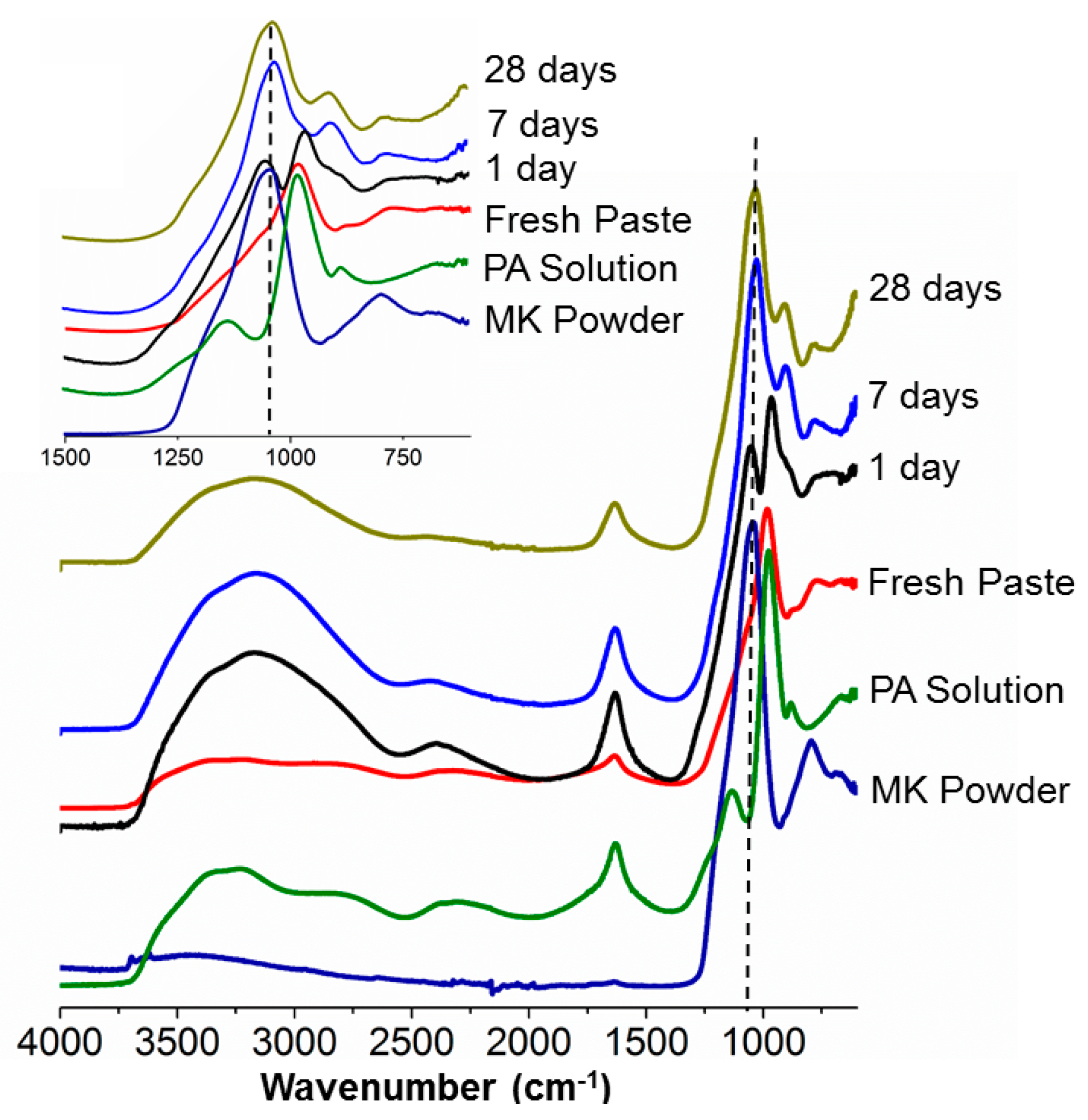
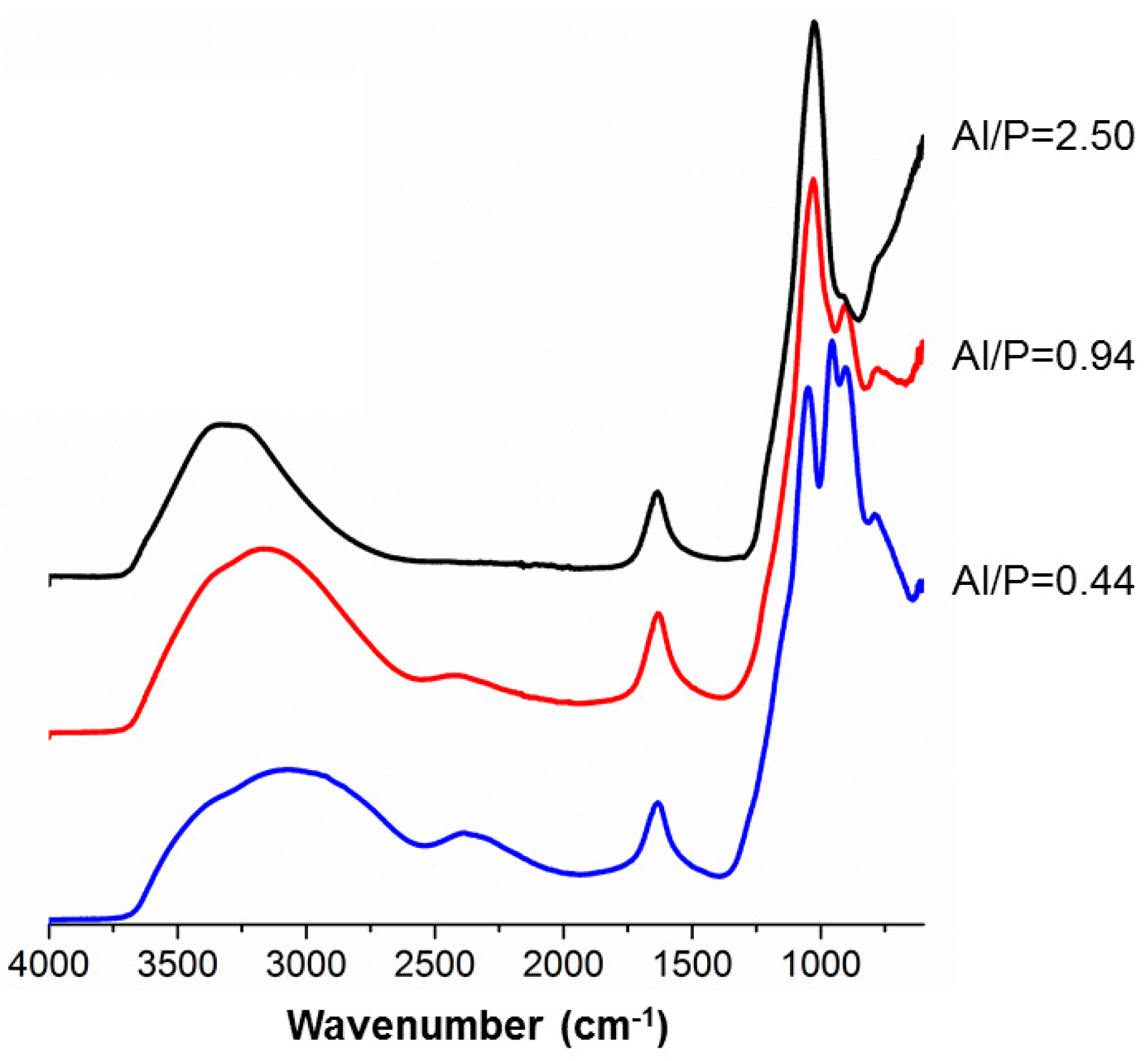
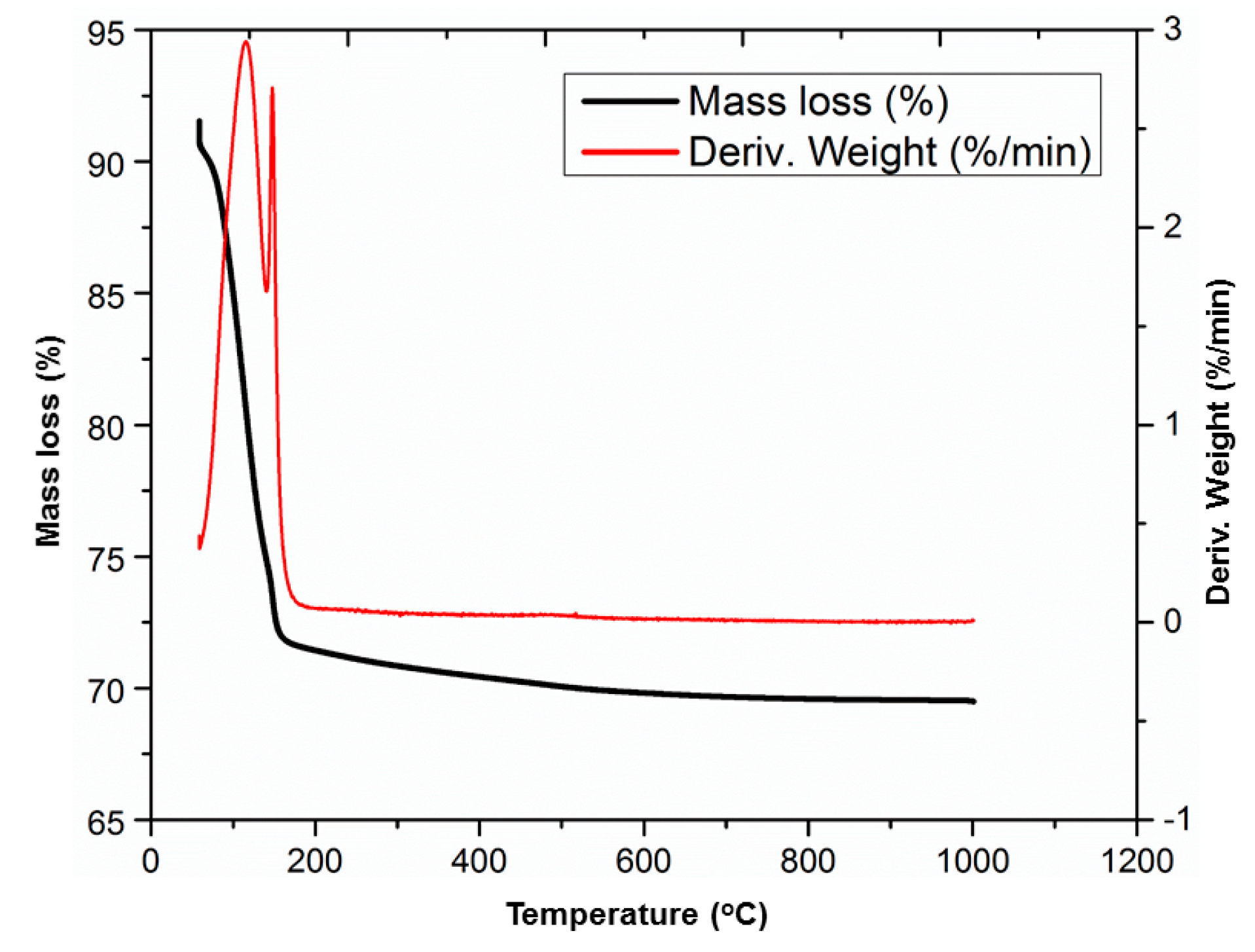
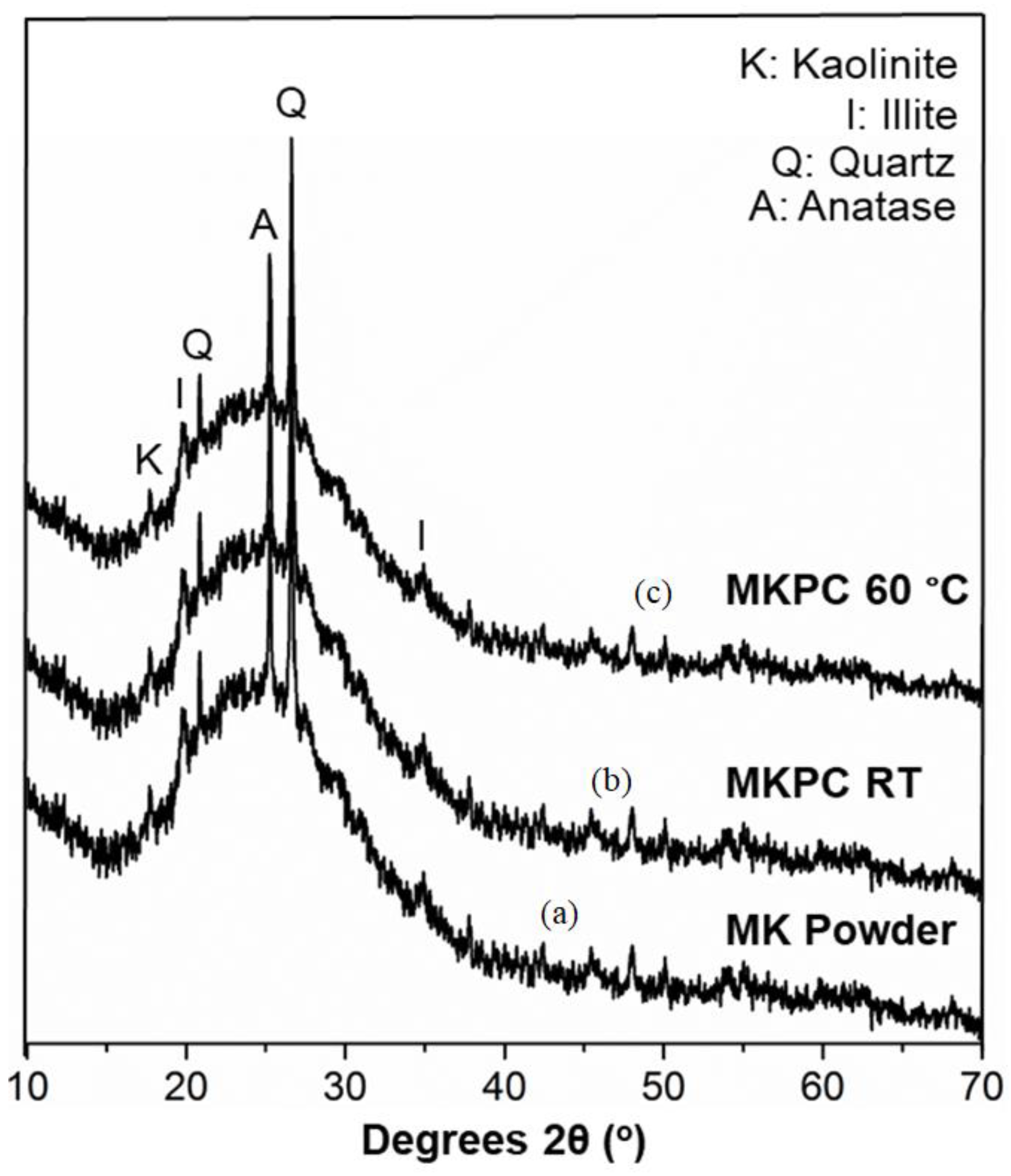
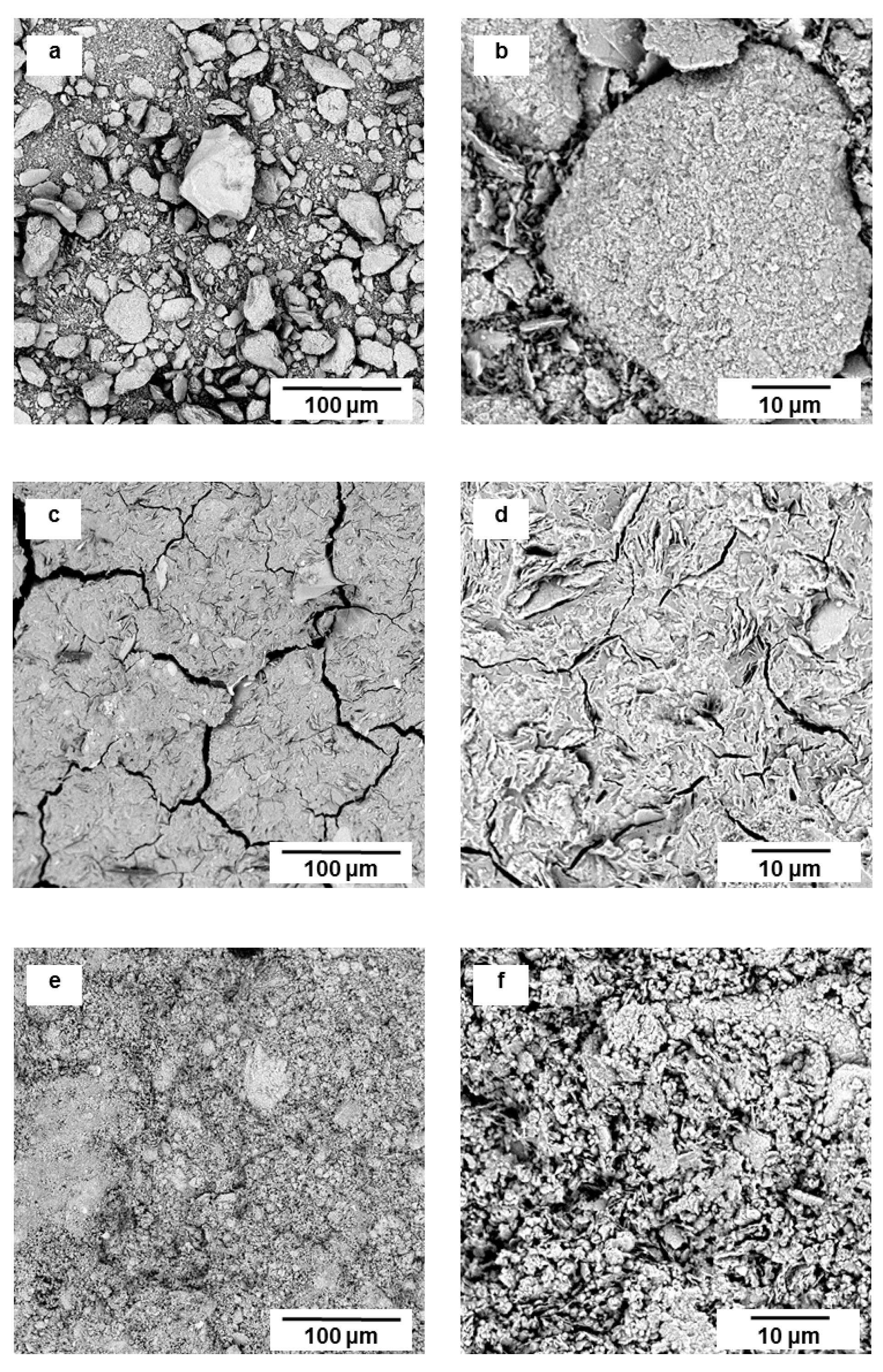
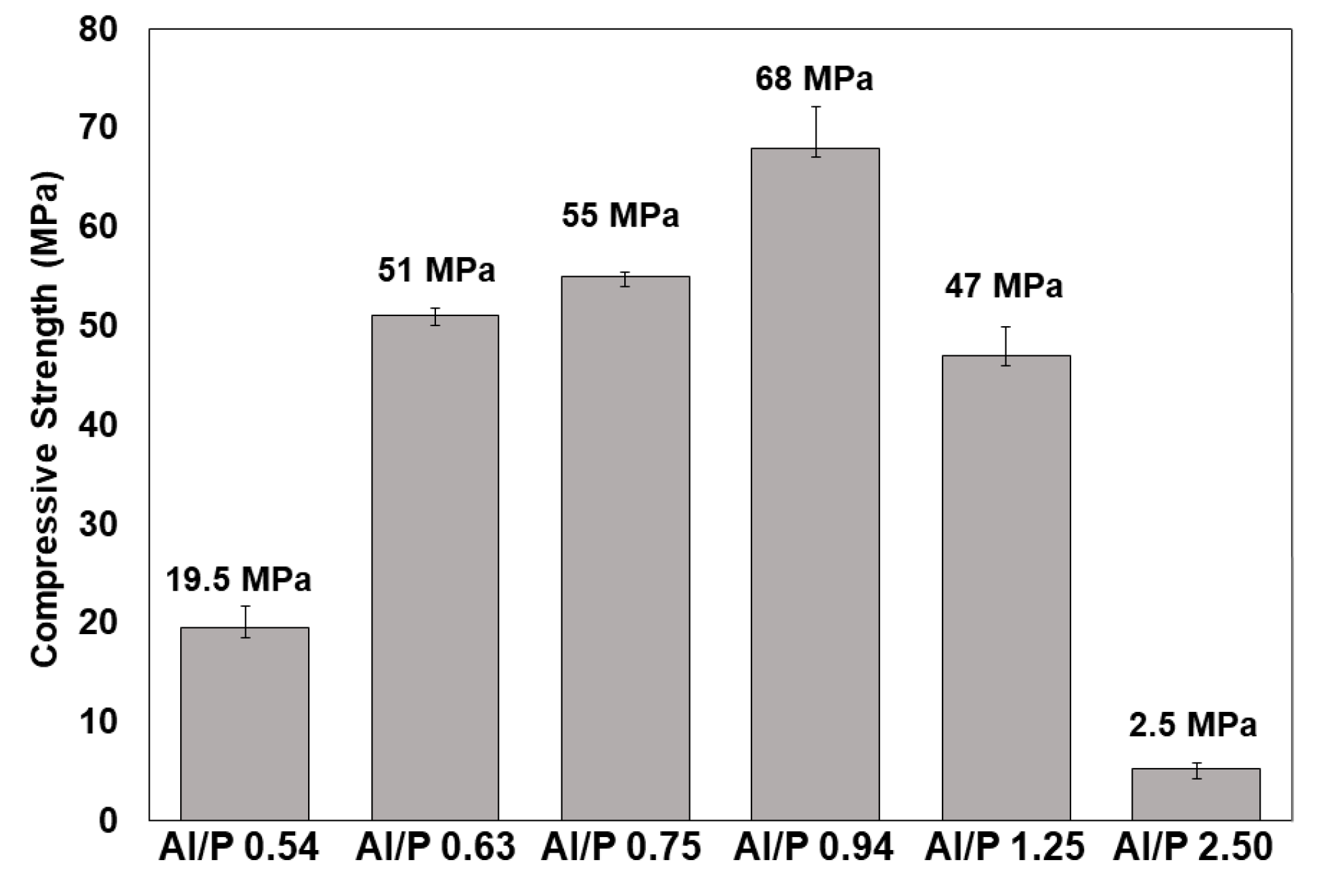
| Compositions (Weight %) | ||||||||
|---|---|---|---|---|---|---|---|---|
| SiO2 | Al2O3 | Fe2O3 | TiO2 | K2O + Na2O | CaO + MgO | P2O5 | LOI | |
| Metakaolinite | 55 | 39 | 1.8 | 1.5 | 1 | 0.6 | - | 1 |
| H3PO4 | - | - | - | - | - | - | 85 | - |
© 2019 by the authors. Licensee MDPI, Basel, Switzerland. This article is an open access article distributed under the terms and conditions of the Creative Commons Attribution (CC BY) license (http://creativecommons.org/licenses/by/4.0/).
Share and Cite
Katsiki, A.; Hertel, T.; Tysmans, T.; Pontikes, Y.; Rahier, H. Metakaolinite Phosphate Cementitious Matrix: Inorganic Polymer Obtained by Acidic Activation. Materials 2019, 12, 442. https://doi.org/10.3390/ma12030442
Katsiki A, Hertel T, Tysmans T, Pontikes Y, Rahier H. Metakaolinite Phosphate Cementitious Matrix: Inorganic Polymer Obtained by Acidic Activation. Materials. 2019; 12(3):442. https://doi.org/10.3390/ma12030442
Chicago/Turabian StyleKatsiki, Antigoni, Tobias Hertel, Tine Tysmans, Yiannis Pontikes, and Hubert Rahier. 2019. "Metakaolinite Phosphate Cementitious Matrix: Inorganic Polymer Obtained by Acidic Activation" Materials 12, no. 3: 442. https://doi.org/10.3390/ma12030442
APA StyleKatsiki, A., Hertel, T., Tysmans, T., Pontikes, Y., & Rahier, H. (2019). Metakaolinite Phosphate Cementitious Matrix: Inorganic Polymer Obtained by Acidic Activation. Materials, 12(3), 442. https://doi.org/10.3390/ma12030442






